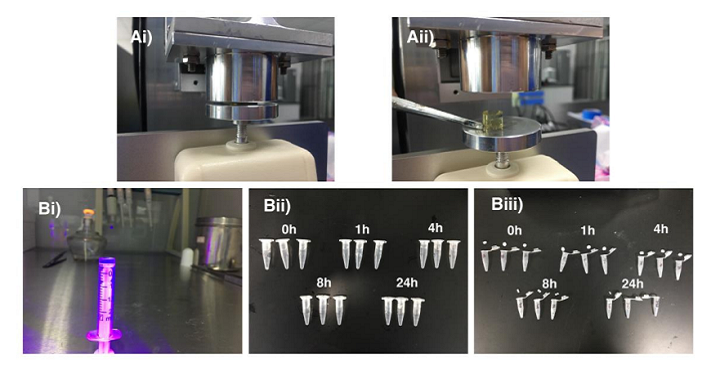While low-concentration gelatin methacryloyl (GelMA) is biocompatible with 3D bioprinted cell‐laden structures, because of its low viscosity it’s hard to stably make organoids, and even microdroplets, with the material. A team of researchers from Zhejiang University in China focused on fixing this problem in a recently published paper, titled “Electro-Assisted Bioprinting of Low-Concentration GelMA Microdroplets.”
The abstract reads, “Here, a promising electro‐assisted bioprinting method is developed, which can print low‐concentration pure GelMA microdroplets with low cost, low cell damage, and high efficiency. With the help of electrostatic attraction, uniform GelMA microdroplets measuring about 100 μm are rapidly printed. Due to the application of lower external forces to separate the droplets, cell damage during printing is negligible, which often happens in piezoelectric or thermal inkjet bioprinting. Different printing states and effects of printing parameters (voltages, gas pressure, nozzle size, etc.) on microdroplet diameter are also investigated. The fundamental properties of low‐concentration GelMA microspheres are subsequently studied. The results show that the printed microspheres with 5% w/v GelMA can provide a suitable microenvironment for laden bone marrow stem cells. Finally, it is demonstrated that the printed microdroplets can be used in building microspheroidal organoids, in drug controlled release, and in 3D bioprinting as biobricks.”
They prepared a prepolymer solution by dissolving freeze-dried GelMA “in modified eagle medium (MEM) at a concentration of 5% (w/v) containing lithium phenyl-2, 4, 6-trimethylbenzoylphosphinate (LAP) at a concentration of 0.5% (w/v),” and then filtering it for sterility, before measuring its viscosity.

Images of different printing states. A) Printing states around the nozzle. B) Continuous atomization in Taylor Jet printing state.
Compressed air was used to feed the bioink into the electro-assisted device.
“Additionally, for preventing the returning of the microdroplets resulting from the attraction of the metal ring, a metal plate connected with the high voltage was placed below the electro-assisted module,” the researchers wrote. “A petri dish with silicon oil was placed on the metal plate as a droplets receiver. The 405nm wavelength light was utilized for the crosslinking of GelMA.”
The team conducted several experiments with their bioink and electro-assisted bioprinting device, including using a high-speed camera, which was set at 1600fps, to examine the various printing states of low-concentration GelMA droplets near the nozzles under the electro-assisted procedure and evaluating the effect on GelMA microsphere size of electrospray parameters.
Confocal Fluorescent Microscopy and Scanning Electron Microscopy (SEM) were both used to complete a series of profile characterizations in order to check out the chemical and physical environment that had been set up by the microspheres. The researchers also analyzed the 5% (w/v) GelMA degradation profile, tested the GelMA bioink’s stress-strain curve, and analyzed the pore area of the 5% (w/v) GelMA material.
“The SEM images of the inner morphology were imported into ImageJ software and transformed into 8-bits gray scale images,” the researchers wrote. “Then, the pore areas of the gray scale images were analyzed. The area frequency distribution and the normal distribution data were calculated. After that, the data were plotted as the form of distribution histogram and normal distribution curve.”
The researchers also examined the potential for using their electro-assisted GelMA microspheres method in a variety of applications, such as cellular encapsulation, drug-controlled release, and 3D bioprinting. To set up a device for 3D inkjet bioprinting, the team used PLA material to fabricate a special fixture on an FDM 3D printer, which was then added to the electro-assisted printing device.
“The metal nozzle was fixed on the fixture and its tip was grounded. Below it, a metal plate was connected with the high voltage,” the researchers explained. “The GelMA bioink with fluorescent particles as above was placed in the syringe of the electro-assisted printing device.”
In order to examine the printability, the team set low gas pressure (0.5kPa) and high gas pressure (1.5kPa), and the microdroplets were extruded down onto filter paper below, which was exposed to 405 nm wavelength light for crosslinking and observed under the confocal fluorescence microscopy after printing was complete.
The team’s research showed that electro-assisted 3D bioprinting of low concentration GelMA microdroplets has a lot of potential in applications such as organoid building, drug delivery, and cell therapy.
Co-authors of the paper are Mingjun Xie, Qing Gao, Haiming Zhao, Jing Nie, Zhenliang Fu, Haoxuan Wang, Lulu Chen, Lei Shao, Jianzhong Fu, Zichen Chen, and Yong He.
Discuss this research and other 3D printing topics at 3DPrintBoard.com or share your thoughts in the Facebook comments below.
Subscribe to Our Email Newsletter
Stay up-to-date on all the latest news from the 3D printing industry and receive information and offers from third party vendors.
You May Also Like
3D Printing Webinar and Event Roundup: April 7, 2024
Webinars and events in the 3D printing industry are picking back up this week! Sea-Air-Space is coming to Maryland, and SAE International is sponsoring a 3D Systems webinar about 3D...
Roboze Brings Performance Polymer 3D Printing to SoCal via New Partnership
High-performance polymer 3D printing firm Roboze has been steadily working to expand its global footprint, with a firm eye on distributed manufacturing, particularly with regard to the oil and gas,...
3D Printing Webinar and Event Roundup: March 3, 2024
In this week’s roundup, we have a lot of events taking place, including SPE’s ANTEC 2024, Futurebuild, the AAOP Annual Meeting, JEC World, and more. Stratasys continues its training courses,...
Advanced Manufacturing Firm Zeda Acquires The Orthopedic Implant Company
Zeda, the San Francisco-based provider of advanced manufacturing solutions, announced that it has acquired The Orthopedic Implant Company (OIC), a medical device manufacturer based in Reno, Nevada, for an undisclosed...


































